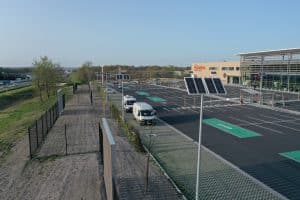About solar lighting 3 April 2025
Lighting is a major concern for retail chains, affecting costs, energy consumption, and carbon footprint. With rising energy prices and increasingly strict environmental regulations, retailers must rethink their strategy. Solar lighting offers the perfect solution—combining cost savings, easy installation, and a strong environmental commitment.

The energy transition is no longer optional—it’s essential. Here’s why solar lighting is perfectly suited to the needs of large retail spaces:
Retail zones must now comply with increasingly demanding regulations. Rather than being constraints, these rules are an opportunity to optimize energy use with more efficient and sustainable solutions.
Getting Ready for the Climate & Resilience Law
By 2028, all commercial parking lots over 1,500 m² must be equipped with solar canopies. Solar lighting is an immediate step toward compliance, turning regulations into a competitive edge.
Lighting isn’t just about compliance—it directly affects user safety and experience (customers and staff alike).
Poor lighting can harm the customer experience and discourage visits, especially in the evening or winter. Visibility, security, and energy performance are top priorities. Sunna Design’s solar streetlights offer a comprehensive solution through smart innovations:
Leading retailers like IKEA, E. Leclerc, and Sport 2000 already trust Sunna Design to secure their facilities and reduce energy bills.
In loading zones and warehouses, where work often goes on after hours, reliable lighting is essential to ensure team safety and efficient operations. Sunna Design brings cutting-edge tech to meet these demands:
Solar lighting is more than an eco-friendly option—it’s a strategic advantage. It lowers operating costs and ensures full regulatory compliance.
Retailers also boost their brand image by aligning with consumers’ growing demand for environmental responsibility. By adopting smart and scalable lighting, they stay ahead of market changes and build resilience against energy price volatility.
